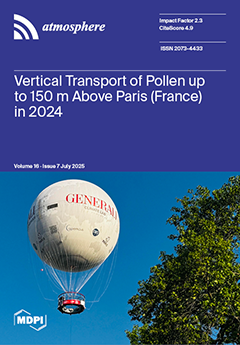We surveyed the air quality conditions in 18 homes with gas stoves for PM
2.5, CO
2, NO
2 and CO using calibrated low-cost sensors. In each home, participants were asked to cook as usual, but to record their cooking activities
[...] Read more.
We surveyed the air quality conditions in 18 homes with gas stoves for PM
2.5, CO
2, NO
2 and CO using calibrated low-cost sensors. In each home, participants were asked to cook as usual, but to record their cooking activities and mitigation efforts (windows, ventilation fans, etc.). All homes showed enhanced pollutants during, and immediately after, times of cooking or stove use. For each home, we quantified the minutes per day and minutes per minute of cooking over known health thresholds for each pollutant. On average, homes exhibited 38 min per day over one or more of these thresholds, with PM
2.5 and NO
2 being the pollutants of greatest concern. Six homes had much higher occurrences over the health thresholds, averaging 73 min per day. We found an average of 1.0 min over one or more of the health thresholds per minute of cooking when no mitigation was used, whereas when mitigation was used (filtration or vent fan), this value was reduced by 34%. We further investigated several mitigation methods including natural diffusion, a commercial HEPA filter unit, a commercial O
3 scrubber and a ventilation fan. We found that the HEPA unit was highly effective for PM
2.5 but had no impact on any of the gaseous pollutants. The O
3 scrubber was moderately effective for NO
2 but had little impact on the other pollutants. The ventilation fan was highly effective for all pollutants and reduced the average pollutant lifetime significantly. Under controlled test conditions, the pollutant lifetime (or time to reach 37% of the original concentration), was reduced from an average of 45 min (with no ventilation) to 7 min. While no commercial filter showed efficacy for both PM
2.5 and NO
2, the fact that each could be removed individually suggests that a combined filter for both pollutants could be developed, which would significantly reduce health impacts in homes with gas stoves.
Full article





